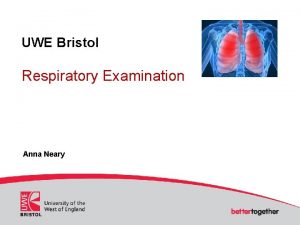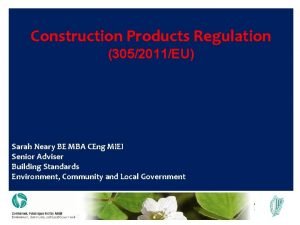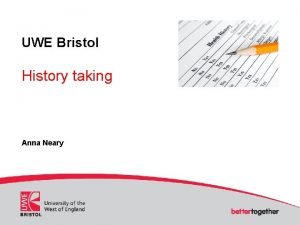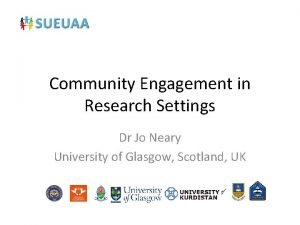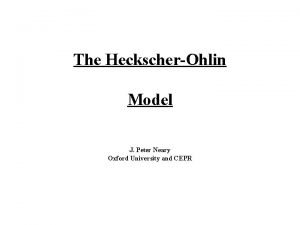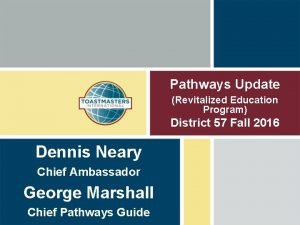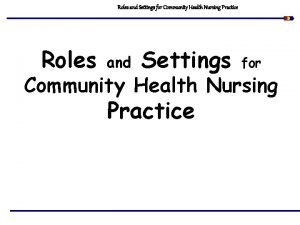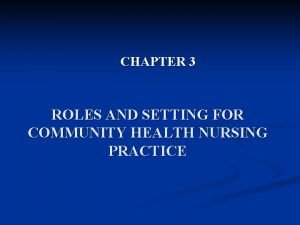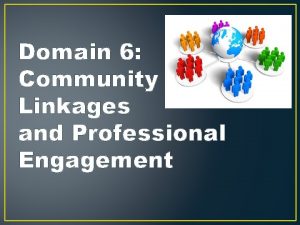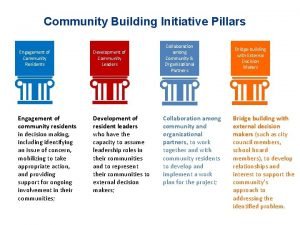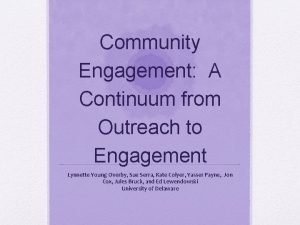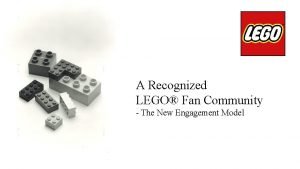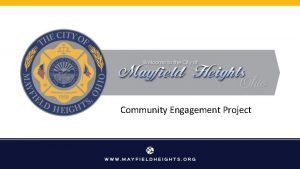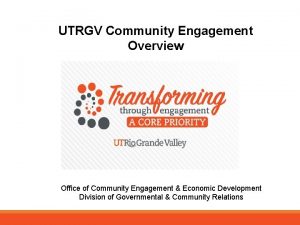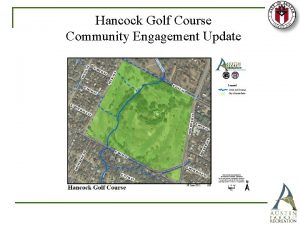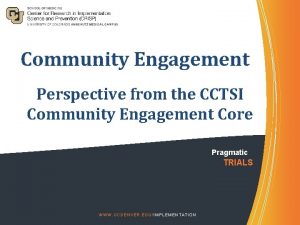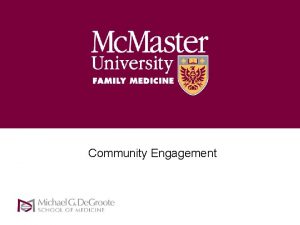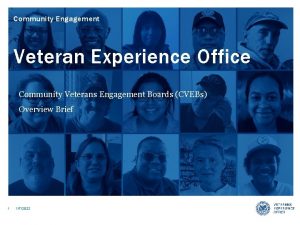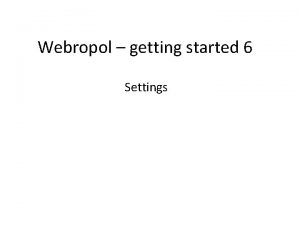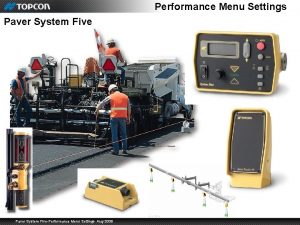Community Engagement in Research Settings Dr Jo Neary


















- Slides: 18

Community Engagement in Research Settings Dr Jo Neary University of Glasgow, Scotland, UK

Scope of presentation • I will be referring to community engagement in terms of the research process, specifically how researchers understand, experience, and write about community engagement • I will be using examples from research conducted in Africa and Asia, but also in Western Europe and North America

Overview (20 min presentation) • Definitions – What is meant by community engagement • How does community engagement benefit our work • How has this been used in health, education, sustainability

Defining community • Lack of uniformity – Dependent on the nature of the research, goal of engagement, and context the research is carried out – The ‘population under study’ (Seely et al, 1992) – Or the group of individuals within a population who share common characteristics (Rotimi et al) • Who defines community? • More than the target population of the study, and includes wider populations also impacted (Morin et al, 2003)

What is community engagement • Can assist in identifying and clarifying communities understandings of research, and inform process • A dynamic process informed by input, and resulting in adaptive change by stakeholders and relationship transformation (Mac. Queen, et al 2014) • A process of working collaboratively with a group of people on a shared goal or common interest (Tindana et al, 2007)

Research projects and community engagement • Majority of community engagement in research settings occurs post-design stage (after ethical approval, funding has been given) – CE is therefore how we identify community need in the context of the research agenda – Where other topics come up, they may form the basis for future research • No ‘one size fits all’ strategy – Depends on nature of research and goals of engagement

Methods of community engagement • Different methods associated with community engagement – Creative methods for eliciting responses (arts based, visual mapping) – Arranging public forums, advisory panels, attending town meetings

Elements of community based participatory research • Collaborative – Involving community in all/some aspects of research – Building capacity and empowerment – Knowledge transfer and exchange • Meaningful engagement activities – Informing research agenda – Interpretation and dissemination of results

Examples of different types of engagement • Arts based approaches: study of designing a water filter intervention in Nepal (Aggett, 2018) using arts based approaches • Combination of methods: Study of orphaned and separated children in Western Kenya (Kamanda et al, 2013) using public meetings, stakeholders, and an expert forum

Common steps to community engagement • Meeting with community prior to research period beginning – Seek agreement as to research parameters, impact on community, consolidating needs of community with research objectives • Create advisory group with key stakeholders – Useful for recruitment, retention, links with ongoing experience of community • Constant feedback – Factor in meetings with community groups during research, feedback emerging results, seek their input as to meaning of data, also to ensure research can be appropriately applied

Points to consider • Practical guidance on community engagement: – Acknowledge capacity and ability of different stakeholders to participate – Acknowledge accessibility issues (location, time demands) – Ensure the purpose and goals of research is clear – Identify, mobilise and develop relevant attitudes – Provide space for dissenting opinions

Benefits of community engagement • Protect communities that are under investigation – Minimise possibility of exploitation – Ensure respect for recruited participants – Ensure awareness of, and respect for, cultural benefits • Increase the likelihood that research will generate benefits locally – Legitimacy of engagement process – Tailor research for needs of community – Longevity of impact • Learn from communities – Take into account local knowledge regarding social/economic/political landscape Adapted from Mac. Queen et al, 2015

Challenges in community engagement “Despite broad support; guidelines and scholarship regarding community engagement are unsettled which can make it difficult to implement and assess- potentially resulting in missed opportunities, wasted resources and poor decisions” (Mac. Queen et al, 2015)

Challenges in community engagement • Differences in demands of the community and that of the University – Is it to improve the quality of the research (and meet funding criteria) OR to have direct long lasting benefit to community – Focusing the engagement into a workable project • Differences in timeframe • Difficulties in evaluating effectiveness

Summary • Community engagement is becoming an increasingly common component of scientific research, development work, policy making, and technology design • However, what community engagement involves often depends on the research remit and often involves different activities • Overall, we say community engagement is participatory, empowering, and informing and may involve a one off discussion, or continual engagement over time • It is not without its challenges concerning evaluating effectiveness, dealing with different demands, or lack of trained staff • But can offer a lot of added value to research settings

Group Discussion • In your groups, consider: – What are the barriers facing Universities from engaging with local communities – What are successful examples of community engagement in Manila • What are the factors which facilitated successful engagement? • How transferable is this community engagement to other contexts either in the Philippines, or more globally?

Thank you Joanne. Neary@glasgow. ac. uk Website: SUEUAA. org Twitter: @SUEUAA 2

References • Mac. Queen et al (2015) Evaluating community engagement in global health research: the need for metrics BMC Medical Ethics 16: 44 https: //bmcmedethics. biomedcentral. com/articles/10. 1186/s 12910 -015 -0033 -9 • Kamanda et al (2013) Harnessing the power of the grassroots to conduct public health research in sub-Saharan Africa: a case study from western Kenya in the adaption of community-based participatory research (CBPR) approaches https: //bmcpublichealth. biomedcentral. com/articles/10. 1186/1471 -2458 -13 -91 • Agget (2018) Turning the gaze: challenges of involving biomedical researchers in community engagement with research in Patan, Nepal https: //www. tandfonline. com/doi/full/10. 1080/09581596. 2018. 14 43203
 Tactile fremitis
Tactile fremitis Sarah neary
Sarah neary Oldcarts
Oldcarts Anna neary
Anna neary Settings
Settings Peter neary
Peter neary Dennis neary
Dennis neary Responsibility of community health nurse
Responsibility of community health nurse Function of community
Function of community Main roles of community setting
Main roles of community setting Domain 6 community linkages and professional engagement
Domain 6 community linkages and professional engagement Four pillars of community engagement
Four pillars of community engagement Kpis for community engagement
Kpis for community engagement Community engagement continuum
Community engagement continuum Lego fan media
Lego fan media Prepare to scale up in social mobilization
Prepare to scale up in social mobilization Vray animation settings
Vray animation settings Vray frame buffer
Vray frame buffer Custom display in ecdis
Custom display in ecdis
